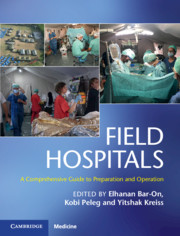Book contents
- Field Hospitals
- Field Hospitals
- Copyright page
- Contents
- Contributors
- Preface
- Section 1 History
- Section 2 Scenarios
- Section 3 Operational Considerations
- Chapter 6 Training and Accreditation
- Chapter 7 Personnel
- Chapter 8 Leading the Mission
- Chapter 9 Coordination and Organization of Medical Relief to Affected Areas
- Chapter 10 Field Hospital Logistics
- Chapter 11 Auxiliary Medical Services in a Field Hospital
- Chapter 12 Information and Communication Technologies in a Field Hospital
- Section 4 Clinical Considerations
- Section 5 Additional Contextual Considerations
- Index
- Plate Section (PDF Only)
- References
Chapter 12 - Information and Communication Technologies in a Field Hospital
from Section 3 - Operational Considerations
Published online by Cambridge University Press: 09 January 2020
- Field Hospitals
- Field Hospitals
- Copyright page
- Contents
- Contributors
- Preface
- Section 1 History
- Section 2 Scenarios
- Section 3 Operational Considerations
- Chapter 6 Training and Accreditation
- Chapter 7 Personnel
- Chapter 8 Leading the Mission
- Chapter 9 Coordination and Organization of Medical Relief to Affected Areas
- Chapter 10 Field Hospital Logistics
- Chapter 11 Auxiliary Medical Services in a Field Hospital
- Chapter 12 Information and Communication Technologies in a Field Hospital
- Section 4 Clinical Considerations
- Section 5 Additional Contextual Considerations
- Index
- Plate Section (PDF Only)
- References
Summary
A disaster creates an information crisis, representing an increased demand for information and a reduced ability to provide it. Chaos poses challenges to a successful field hospital operation which must be organized, orderly, and be data driven. Information needs include creating a unique namespace, tracking and documenting medical information, tracking stocks, utilization of medical supplies, and critical hospital assets. A field hospital information system should create situational awareness for key personnel at all times. Clinical data record keeping is an ethical as well as a legal and a practical need, enabling continuity of care. Elaborate planning is crucial. A small IT team must possess diverse skills necessary to handle various tasks including system and network deployment and administration, application support, and telecommunication equipment deployment and support. While developing software emphasis should be given to ease of use, robustness, simultaneous updates by many users, quick user switching, safeguarding data confidentiality while maintaining usability and throughput and interfaces with imaging and lab equipment. Hardware must be robust and immune to power shortages. A combined local area network comprising of wired and wireless components is preferred. Redundancy and backup are key. Regular training of IT personnel must be performed toward a real deployment. Communication capabilities are crucial to a successful deployment.
Keywords
- Type
- Chapter
- Information
- Field HospitalsA Comprehensive Guide to Preparation and Operation, pp. 101 - 118Publisher: Cambridge University PressPrint publication year: 2020



